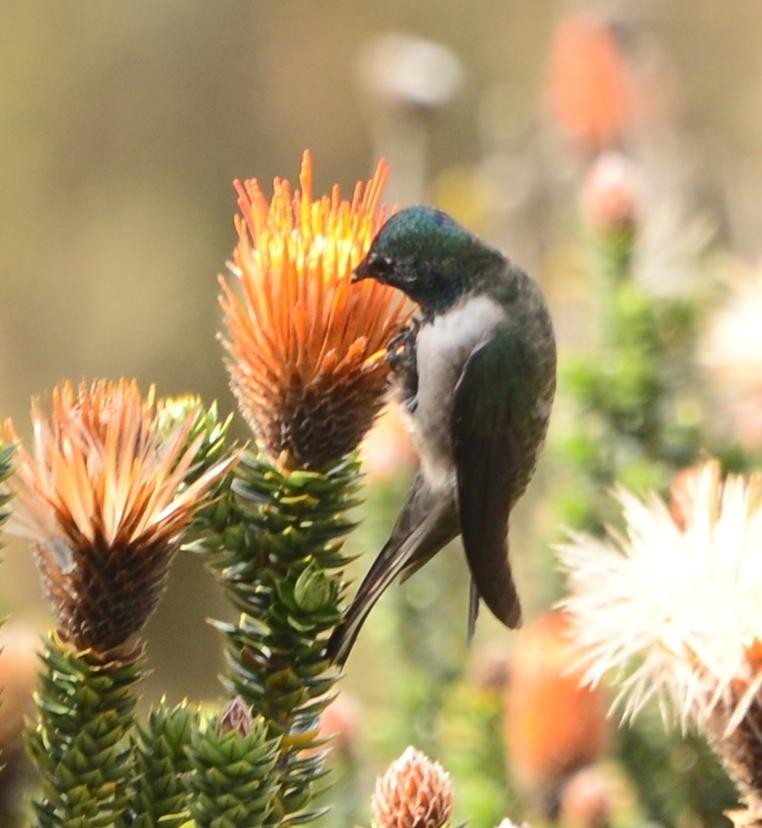Ecuadorian Hillstar
A species of Hillstars Scientific name : Oreotrochilus chimborazo Genus : Hillstars
Ecuadorian Hillstar, A species of Hillstars
Botanical name: Oreotrochilus chimborazo
Genus: Hillstars
Content
Description General Info
 Photo By damontighe , used under CC-BY-NC-4.0 /Cropped and compressed from original
Photo By damontighe , used under CC-BY-NC-4.0 /Cropped and compressed from original Description
The length of this species is about 12 cm, and it weighs approximately 8.0 g. It has a black bill that is slightly decurved and is about 2 cm long. The male has a glittering violet purple hood bordered below by a horizontal black chest stripe. It is dark olive green above and white below with a dark line down the center of the belly. The central tail feathers are blue-green and the rest are mostly white with black tips and edges. Females are duller dusty olive green above with a whitish throat speckled with brown spots. Its tail is dark and the rest of its underparts are pale grayish. There are two subspecies and the males can be distinguished by their throat. The entire throat of the O. c. jamesonii subspecies is glittering violet purple, but the O. c. chimborazo subspecies has a violet-purple upper throat and a glittering aquamarine patch on its lower throat. Both have the black chest stripe bordering the throat. O. c. chimborazo is found around the Chimborazo and Quilotoa volcanoes and the intervening paramo, but O. c. jamesonii is more widespread. It occurs in favorable habitats from southern Columbia to the mountains of Azuay Province, especially around the volcanoes of Cotacachi, Pichincha, Antisana, Iliniza, and Cotopaxi. A third subspecies, O. c. soederstromi, is thought to be endemic to the volcano Quilotoa in Ecuador. This subspecies, however, has not been recorded since the time of its description. Moreover, the description fits that of an intergrade between the other two subspecies. Both O. c. chimborazo and O. c. jamesonii have been recorded at the type locality of O. c. soderstromi. This third subspecies, thus, may not be a valid one. 
Size
13 cm
Nest Placement
Cliff
Feeding Habits
Ecuadorian Hillstar clings to flowers like Chuquiraga insignis for nectar instead of hovering and consumes insects by hawking or gleaning from surfaces, showing territorial and adaptable feeding behaviors.
Habitat
The habitat of ecuadorian Hillstar comprises the highest vegetated zones near the upper border of the páramo ecosystem, typically in arid, puna-like grasslands, occasionally with sparse trees and shrubs. These birds also inhabit more humid páramo areas and rocky slopes, often near secluded ravines. Ecuadorian Hillstar adapts to man-made environments such as pastures modified by burning. For nocturnal roosting and weather protection, they utilize natural shelters like caves and crevices.
Dite type
Nectivorous
General Info
Feeding Habits
Bird food type
Behavior
Nectar is a very important food for the Ecuadorian hillstar and their main source is the orange flowers of the Chuquiraga shrub. For a hummingbird, its feet are relatively large and instead of hovering while feeding, they usually land and feed while clinging to the plant. This behavior saves energy in the cold environment where they live. Insects are another important food source, many of which are caught in the air or foraged in the vegetation and along the cliffs. At night or when the weather is bad they seek shelter in caves or crevices in ravines. During the night they go into a torpid state to conserve energy. To protect from the weather, nests are often built in caves or on the walls of steep ravines, usually with an overhang for added protection from hail, rain, and the midday Sun. Some nests are built in protective bushes. The nests are very large for a hummingbird and are built out of warm material like grass, moss, feathers, plant down, horse hair, and rabbit fur. In highly desirable locations, several nests may be found in close proximity. The clutch size is two, and he male does not participate in the nest building, incubation of the eggs, or feeding of the young. 
Scientific Classification
Phylum
Chordates Class
Birds Order
Swifts and hummingbirds Family
Hummingbirds Genus
Hillstars Species
Ecuadorian Hillstar